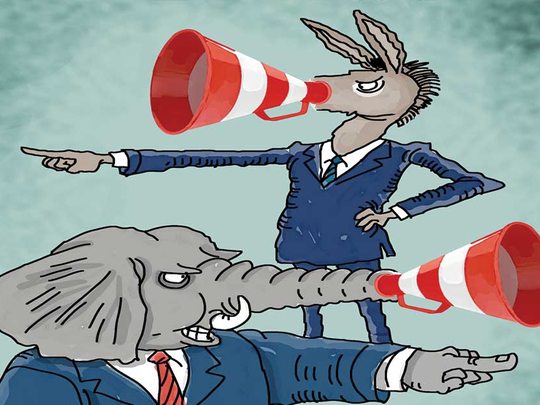
Populism is hard to ignore in the current primary elections. Donald Trump, the self-described political outsider, is promising to “make America great again” by defending the people against Washington insiders, whom he portrays as self-interested, corrupt and incompetent. Senator Bernie Sanders of Vermont touts his track record as a longtime advocate of working people, ready to take on Wall Street and a corrupt campaign finance system.
As a result, many pundits proclaim that this election is ushering in a new era of populist politics.
But is populism really uncommon in US presidential discourse? Our analysis of the past 12 presidential elections, presented in a forthcoming Social Forces article, suggests otherwise. Populism appears frequently in presidential campaigns, and it does so in a patterned and predictable way.
What counts as populism?
We examined all of the speeches given by Democratic and Republican presidential candidates between 1952 and 1996 in the two months before Election Day (no speeches were available for Barry Goldwater’s 1964 campaign). Using a combination of close reading and automated methods, we identified speeches that contained populist language. Like other scholars, we defined populism as a moral opposition between the people, seen as the rightful source of political power, and corrupt elites, who have abandoned the common good for the pursuit of their own interests.
An excerpt from Bill Clinton’s 1992 speech illustrates this type of political talk:
“If you wanted to do something to pollute the environment, you got quick access in Washington, but if your job was cleaning up the streets, all you got was a tax increase [] If you were a slick Washington operator, you got whatever you wanted. I think we ought to turn all that around and go back to good old American common sense.”
We treat this passage as populist because it juxtaposes the people (hard-working Americans, like those “cleaning up the streets”) with the elites (“slick Washington operator[s]”) and accuses the latter of a moral transgression (serving the interests of big business).
Who uses populist rhetoric and why?
Although many of the current media discussions focus on populism among Republicans, the excerpt above comes from a speech by a Democratic candidate. This illustrates our first major finding, which is consistent with historical research on the topic: For the past 60 years, populism has been a recurrent feature of US presidential elections among candidates from both parties. Yet while both Democrats and Republicans have relied on populism, they have done so in distinct ways: Democratic candidates tend to attack economic elites, while most Republicans target elected politicians and bureaucrats.
Second, we find that the farther away a candidate is from Washington’s corridors of power, the more likely he is to use populist language (all of the candidates in our data were men). Sitting presidents and former vice presidents are the least likely to make populist claims, followed by members of Congress and then by governors, and finally by candidates who do not hold an elected position when running for office. Politicians with lengthy careers tend to use populism less often than those with shorter political resumes.
Third, politicians vary in how much they rely on populism, depending on their audience and the campaign’s stage. Challengers begin with populist appeals that cater to their base and then use more moderate language when speaking to a general audience. By contrast, incumbents are less populist at the outset than challengers but gradually adjust their rhetoric over time to more closely match their populist opponents. Candidates also use populist language where it is likely to resonate most: Historically, Republicans have been least likely to rely on populism when giving speeches in the Northeast; Democrats have been most likely to use populism in the labor-dominated Midwest and urban Northeast.
Finally, the same candidate’s use of populism can vary across campaigns. Seven of the politicians we examined ran for office multiple times, either after losing a campaign or as sitting presidents running for reelection. All of them adjusted their campaign rhetoric as they did so, partly because the circumstances mentioned above — their previous role in politics, length of their career, etc. — had changed.
For instance, in 1952, 42 per cent of Dwight D. Eisenhower’s speeches contained populist language, compared with only 11 per cent in 1956, when he could no longer claim to be an outsider. Similarly, Clinton was more populist in 1992 than in 1996, by 28 percentage points, as was Nixon in 1970 compared with 1974, by 14 points. This suggests that populism isn’t a specific candidate’s fixed ideology but rather a carefully crafted campaign strategy.
What does this tell us about the 2016 election?
Given all of this, it is no surprise that Trump — and for that matter, Sanders — are relying on populism. Both are self-described political outsiders, the most likely political actors to use anti-elite language. At the same time, pundits may be right to claim that Trump will eventually tone down his rhetoric (he may already be doing so), as other candidates have when nearing Election Day.
But Trump’s rhetoric has one unique feature: He has adopted a kind of economic populism that’s more often used by Democrats — and by European radical-right politicians — than by Republican candidates. Thus far, this unorthodox strategy — combined with nationalism, dog-whistle politics and crude attacks on his opponents — has benefited Trump in the primary.
Whether this approach will continue to be effective in the general election is yet to be seen. Whatever the outcome, one thing appears to be clear: The populist style in US politics has a long history in both parties, and it continues to shape presidential rhetoric today in patterned ways.
— Washington Post
Bart Bonikowski is an assistant professor of Sociology at Harvard University, where his research focuses on nationalism and populism in the United States and Europe. Noam Gidron is a graduate student in Harvard’s government department.










